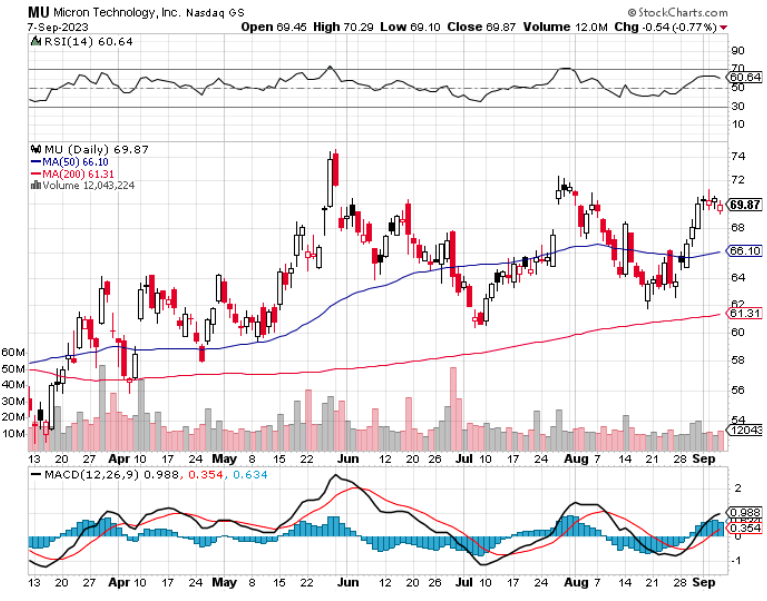(MU), (NVDA)
When it comes to technology, even the giants can be caught off guard.
Amid the backdrop of an AI boom, certain traditional tech sectors—like general-purpose servers, PCs, and smartphones—have seen their glow dim, with sales rhythms more reminiscent of a slow waltz than the exuberant cha-cha of yesteryears. The lingering specter of our recent pandemic and mounting interest rates have cast these gadgets into the shade.
Yet, even as AI dominates the tech discourse, several dark horses remain on the fringes, overlooked but ready for their moment in the sun. One such name is Micron Technology (MU).
Micron Technology's year was punctuated with challenges that harked back to 2008's memory slump. In the tech realm, memory behaves much like oil in the global market—standardized and swaying to the whims of supply and demand. The major players in the DRAM game have recalibrated their tactics, paring down production by a notable third.
As a result, this memory chip company faced a storm, reeling from a severe downturn, its worst since the 2008 fiasco. The waning appeal of PCs post-pandemic, the erratic behavior of smartphones, and server shipments gasping for breath collectively strained the demand for dynamic random-access memory (DRAM) and NAND chips, upsetting the equilibrium of supply.
Adding fuel to the fire, China's Cyberspace Administration took a combative stance, barring its domestic infrastructures from procuring Micron's chips.
By June's close, Micron's quarterly report showed a sobering reality—a 57% YoY drop in revenue, wrapping up June 1. But hope wasn't entirely lost.
A marginal sequential improvement hinted at a demand, albeit slow, awakening from its stupor. Price dynamics, however, painted a less optimistic narrative, with DRAM's average costs receding 10% quarter-on-quarter and NAND's dipping into the mid-teens.
Embracing the collective industry sentiment, Micron turned judicious, reining production and pruning its capital expenditure. The revised playbook witnessed a 30% cut in DRAM and NAND chip production starts—a trend projected to hold sway into 2024. The fiscal 2023 capex? It saw a stark 40% reduction from its previous year.
But herein lies Micron's masterstroke, reminiscent of a Houdini act—retraction in production and expenditure, executed just as the tech plot seems poised for a twist.
While conventional PCs and smartphones may have reached their zenith, memory prices—historically—are a roller-coaster, even in stable times. The global pandemic, however, threw in a wild card, sending prices soaring as demand swirled unpredictably.
This is where AI comes in.
The AI server domain, by all accounts, is primed for explosive growth. Projections chart a trajectory from $30 billion to a whopping $150 billion by 2027, effectively mirroring the trajectory of our standard server market.
The implications for Micron? AI servers are voracious for DRAM and NAND, demanding 6-8 times and thrice the amount, respectively, compared to their generic counterparts.
NVIDIA (NVDA), AI's reigning monarch, has unveiled its H100 data-center GPU—an engineering marvel equipped with 188GB of high bandwidth memory 3 (HBM3). Fast and efficient, it's poised to be AI processing's poster child.
Experts are hedging their bets on HBM3 and DDR5 memory to revitalize the DRAM market. And if these projections crystallize, the third quarter could mark a watershed moment.
Although a latecomer to the HBM fest, Micron made a dramatic entry in July, parading its HBM3 chips, promising a 50% bandwidth elevation over existing titans. With the horizon of 2024, Micron's ledger might see a healthy inflow from this endeavor.
The overarching narrative?
Analysts now anticipate that by 2024, Micron might not just match but potentially overshadow rivals like SK Hynix and Samsung. When it teased the industry with its HBM3 chip—24GB across eight layers, boasting over 1.2 TB/s, it easily outclassed SK Hynix's version.
Yet, Micron's portfolio isn't merely confined to HBM. They pulled ahead of their competition in the non-AI memory segment in 2022, unveiling the 232-layer NAND flash and 1-beta DRAM. This prowess insulated Micron during industry lows.
Micron's trajectory in the face of adversity mirrors the greater ebb and flow of the memory market. Like a roller coaster, fortunes rise and plunge with dizzying rapidity. This downturn was undeniably steep, propelling dominant players to adopt austerity measures. Yet, the insatiable hunger of AI for memory hints at an impending surge.
In its relentless march, artificial intelligence has a unique way of rejuvenating dormant giants. Micron's recent technological leaps set it apart. As the world stands at the cusp of another AI-driven metamorphosis, Micron emerges as the stock to watch, encapsulating the very essence of the industry's capacity for renewal and resurgence.



